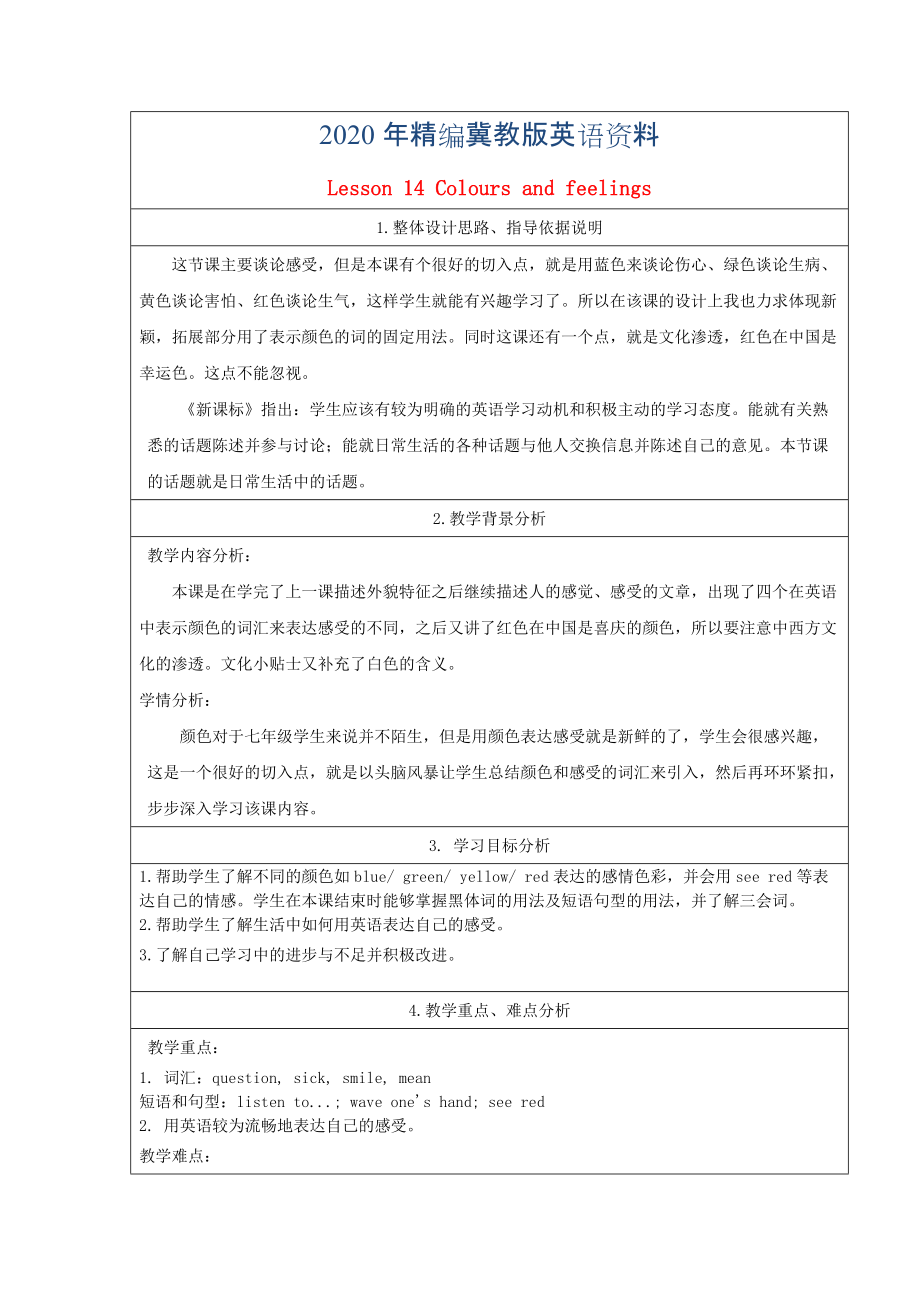《2020年【冀教版】七年級上冊:Unit 3 Lesson 14 Colours and feelings教案》由會員分享,可在線閱讀,更多相關(guān)《2020年【冀教版】七年級上冊:Unit 3 Lesson 14 Colours and feelings教案(6頁珍藏版)》請在裝配圖網(wǎng)上搜索���。
1���、2020年精編冀教版英語資料
Lesson 14 Colours and feelings
1.整體設(shè)計思路���、指導(dǎo)依據(jù)說明
這節(jié)課主要談?wù)摳惺埽潜菊n有個很好的切入點���,就是用藍色來談?wù)搨摹⒕G色談?wù)撋?��、黃色談?wù)摵ε?��、紅色談?wù)撋鷼?��,這樣學(xué)生就能有興趣學(xué)習(xí)了���。所以在該課的設(shè)計上我也力求體現(xiàn)新穎���,拓展部分用了表示顏色的詞的固定用法���。同時這課還有一個點���,就是文化滲透,紅色在中國是幸運色���。這點不能忽視���。
《新課標(biāo)》指出:學(xué)生應(yīng)該有較為明確的英語學(xué)習(xí)動機和積極主動的學(xué)習(xí)態(tài)度。能就有關(guān)熟悉的話題陳述并參與討論���;能就日常生活的各種話題與他人交換信息并陳述自己的意見���。本節(jié)課的話題就是日常生活中的話題
2、���。
2.教學(xué)背景分析
教學(xué)內(nèi)容分析:
本課是在學(xué)完了上一課描述外貌特征之后繼續(xù)描述人的感覺���、感受的文章���,出現(xiàn)了四個在英語中表示顏色的詞匯來表達感受的不同���,之后又講了紅色在中國是喜慶的顏色,所以要注意中西方文化的滲透���。文化小貼士又補充了白色的含義���。
學(xué)情分析:
顏色對于七年級學(xué)生來說并不陌生,但是用顏色表達感受就是新鮮的了���,學(xué)生會很感興趣���,這是一個很好的切入點,就是以頭腦風(fēng)暴讓學(xué)生總結(jié)顏色和感受的詞匯來引入���,然后再環(huán)環(huán)緊扣���,步步深入學(xué)習(xí)該課內(nèi)容。
3. 學(xué)習(xí)目標(biāo)分析
1.幫助學(xué)生了解不同的顏色如blue/ green/ yellow/ red表達的感情色彩���,并會用see r
3���、ed等表達自己的情感���。學(xué)生在本課結(jié)束時能夠掌握黑體詞的用法及短語句型的用法,并了解三會詞���。
2.幫助學(xué)生了解生活中如何用英語表達自己的感受���。
3.了解自己學(xué)習(xí)中的進步與不足并積極改進。
4.教學(xué)重點���、難點分析
教學(xué)重點:
1. 詞匯:question, sick, smile, mean
短語和句型:listen to...; wave one's hand; see red
2. 用英語較為流暢地表達自己的感受���。
教學(xué)難點:
用正確恰當(dāng)?shù)姆绞奖磉_自己的感受,并能適當(dāng)調(diào)節(jié)���。
5.教學(xué)過程設(shè)計
Step 1 Greetings:
Greet the students
4���、
Step 2 Warm-up: Brainstorm:
Write down as many words about colours and feelings as they can. (寫出關(guān)于顏色、感覺的詞匯)
[設(shè)計思路:利用頭腦風(fēng)暴讓學(xué)生以最短的時間寫出關(guān)于顏色和感覺的詞匯���,利于后面的新知學(xué)習(xí)���。]
Step 3 Learn the new words.
Show the students some pictures and sentences and help them to learn how to use the words and phrases correctly a
5、nd freely.
singer [?s???]] n. 歌手
Michel Jackson is one of my favorite singers. He sang a lot of songs, like The earth song, Thriller, We are the World and so on.
feeling [?fi:l??] n 感覺���;情感(常用作復(fù)數(shù))
—What’s your feeling?
—I feel hot and I want to eat an ice cream.
question[?kwest??n]
6���、n. 問題
The girl wants to answer the teacher’s question. She is really active.
sick [sik] adj. 病的;生病的
The child feels sick. He has a bad stomachache.
scared [ske?d] adj. 恐懼的
---What are you scared of?
---I’m scared of scary animals.
smile [smail] n. &v. 微笑
A girl shows a board w
7���、ith a smiling face during an activity to celebrate the upcoming World Smile Day at No. 10 Middle School in Xingtai, north China's Hebei Province, May 7, 2009. The World Smile Day falls on May 8.
wave [weiv] v. 揮手���;招手
Santa Claus is waving his hand to us. He is saying hello.
mean [mi:n]] v. 意
8、思是 adj.刻薄的
1. What do you mean by saying that?
2. Don’t be so mean to others, or you’ll lose friendship.
* What’s the meaning of this word?
(設(shè)計意圖:通過圖片展示新詞���,突出重點���、突破難點;通過語篇進行解釋���,使學(xué)生利用語境記單詞和短語的含義���。)
Step 4 Remember the new words as quickly as possible. Then fill in the blanks with the new wo
9���、rds and expressions.
singer [?s???]] n. 歌手
feeling [?fi:l??] n 感覺;情感(常用作復(fù)數(shù))
question[?kwest??n] n. 問題
sick [sik] adj. 病的���;生病的
scared [ske?d] adj. 恐懼的
smile [smail] n. &v. 微笑
wave [weiv] v. 揮手���;招手
mean [mi:n]] v. 意思是 adj.刻薄的
Ask the students to have a competition, see which studen
10、t can remember the most new words.
[設(shè)計思路:通過競賽激發(fā)興趣���,通過展示音標(biāo)幫學(xué)生正音���。通過趁熱打鐵及時練習(xí),掌握新詞匯���,為新授課打基礎(chǔ)���。]
Step 5 Listen and answer the questions:
1. What does green mean?
2. What does yellow mean?
3. What is Li Ming doing?
[設(shè)計思路:鍛煉學(xué)生通過聽力捕捉重要信息的能力。]
Step 6 Read the lesson and do the following exercise.
Fou
11���、r words in this passage are NOT right. Circle them and write the correct words on the blanks below.
It’s my birthday today. I am so angry! All of my friends will come to my house. But my friend, Jenny, doesn’t feel well. She is happy and she can’t come. That makes me feel tired. I really want her t
12���、o be here. But it’s OK. I know she wants me to have a sad birthday.
1. ______ 2. ______ 3. ______ 4. ______
[設(shè)計思路:通過讀課文���,掌握大意及細節(jié)信息,通過找錯誤���,捕捉關(guān)鍵信息。]
Step 7 Strike while the iron is hot.
1. My mom and my aunt are both ______(sing).
2. These q__________ are easy to answer.
3. You can see many s__
13���、____ people in the hospital.
4. Look! The little baby _____________(smile).
5. Expensive _______(意思是) dear.
6. I like ______________(聽) music in my free time.
7. Don’t ______________(火冒三丈). She is only a child.
8. When you say goodbye to others, you often _____________(揮手).
9. can, how, a, fe
14���、el, you, colour
_______________________________?
10. in, happy, China, is, red, a, colour
_______________________________.
11. He’s not mean. (英譯漢)
_______________________________.
12. I feel blue.(寫出同義句)
______________________________.
[設(shè)計思路:通過練習(xí),掌握詞匯及文中重點知識���。]
Step 8 Work in pairs. Wha
15���、t do you like or not like to do? What makes you feel happy, sad, angry, scared or sick? Talk about it, write it down and draw a picture.
Example:
I like to play with my friends. It makes me feel happy.
I don’t like to watch scary movies. It makes me feel scared.
[設(shè)計思路:通過兩個人一個小組的合作,描述自己喜歡做的
16���、和不喜歡做的���,突破難點。]
Step 9 拓展:
1. black sheep ____________
2. black tea ____________
3. a white lie ____________
4. the White House ____________
5. white elephant ____________
6. out of the blue ____________
7. black and blue ____________
8. in the red ____________
9. in the pink ____________
1
17、0. pink eye ____________
你還知道其他跟顏色有關(guān)的短語的含義嗎���?跟大家一起分享���!
[設(shè)計思路:通過拓展跟顏色相關(guān)的俗語,擴大學(xué)生的知識面���,同時激發(fā)興趣���,也關(guān)注了中西方文化的差異。]
Homework:
1. Read the text fluently and remember the expressions about colors and feelings.
2. Do the exercises 1 and 2 on Page 37.
3. Listen and read the passage “Bringing Color to
18���、 Life and Tears to Eyes With a Natural Dye” to know more about colors.
6.教學(xué)評價設(shè)計
Self-evaluation(自我評價):
1. 我能夠聽懂本課語段���,識別主題并獲取主要信息。 ☆ ☆ ☆ ☆ ☆
2. 我能就本課話題進行簡單地交流和書面表達���。 ☆ ☆ ☆ ☆ ☆
3. 我能夠記住紅色���、藍色、白色���、綠色和黃色的含義���。 ☆ ☆ ☆ ☆ ☆
4. 這節(jié)課我很有收獲���。 ☆ ☆ ☆ ☆ ☆
《新課標(biāo)》指出:英語課程評價體系要有利于學(xué)生綜合語言運用能力的發(fā)展,采用多元化的評價方式���,注重形成性評價,鼓勵學(xué)生開口說英語���。同時最后的自我評價,能使學(xué)生了解本課的學(xué)習(xí)效果。
7.教學(xué)反思
本課教學(xué)以顏色話題展開感覺���、感受的主題���,本身課的設(shè)置就利于學(xué)生產(chǎn)生興趣,我這個設(shè)計又本著以學(xué)生的學(xué)習(xí)實際為基礎(chǔ)���,比如以他們熟知并喜歡的邁克爾杰克遜等展開新詞的教學(xué)���,他們覺得很有吸引力���,同時各環(huán)節(jié)設(shè)置考慮了學(xué)生的實際生活,通過合作���,猜詞義���,拓展等形式來多角度分析課文,利于學(xué)生接受���。作業(yè)中設(shè)計了拓展的課外閱讀���,對學(xué)生是一種導(dǎo)向。
 2020年【冀教版】七年級上冊:Unit 3 Lesson 14 Colours and feelings教案
2020年【冀教版】七年級上冊:Unit 3 Lesson 14 Colours and feelings教案

